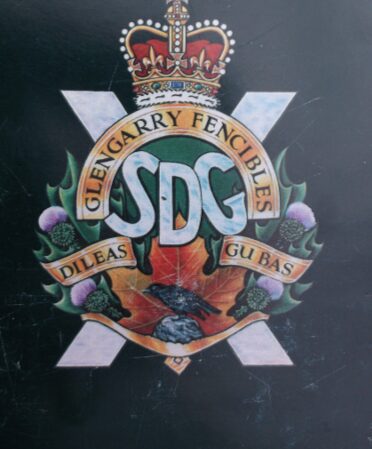FAITHFUL UNTIL DEATH …the SD& G HIGHLANDERS and the CORNWALL ARMOURY
A reader asked me to provide a history of Cornwall’s towered and crenellated Scottish Baronial style Armoury, home of the SD & G Highlanders and the City’s most impressive building.
Now, before I focus on the history of the Armoury, I am going to trace a short history of Our Regiment.
The motto DILEAS GU BAS means FAITHFUL UNTO DEATH.
Settled by approximately 1,000 United Empire Loyalist citizen/soldiers and their families in 1784, Cornwall and SDG has a long and proud military heritage, with local men coming to Eastern Ontario’s defence numerous times during the War of 1812, the Rebellions of 1837/38 and the Fenian Raids. Yet, curiously, the militia did not have a permanent home until the late 1930s.
This was not for want of effort. After the Fenian Raids of the 1860s, a small drill shed was constructed on Lot 16 Fourth St., on the southwest corner, on the site of the old Town Hall and was probably used by the 59th Regiment Stormont and Glengarry Infantry. It was obviously inadequate, as in 1901 the Unit were still petitioning for a permanent home.
The request was held up when Alexandria native, A.G.F. Macdonald became the Regiment’s Commanding Officer. A key figure in local politics, Macdonald, “hit it off” with Canada’s Minister of Defence Sam Hughes, and convinced him to award Alexandria one of the 56 armouries being constructed in Edwardian Ontario, over Cornwall, in 1913. Opened in 1914, the Armoury, which is still standing, was closed as a military base in the fall of 1963.
Cornwall entered World War I without an armoury and used Ross Mill for recruiting purposes. After the War, conditions for the Regiment did not improve and drill practice was held either in a room at the Customs’ Office in the Post Office, or in the basement of C.C.V.S.
The Regiment, now named the Stormont, Dundas and Glengarry Highlanders, finally found a political champion in neophyte Liberal M.P. Lionel Chevrier, who made building an armoury his first project. Coordinating provincial, municipal, county and federal authorities, Chevrier was able to have construction start on this $250,000 armoury in April, 1938. The last of a dozen armouries built between the two World Wars, and Cornwall’s third Public Building since Confederation, it was designed by Charles Devlin Sutherland, Chief Architect for Canadian Public Works and his staff. Erected by A.I. Garvock Construction of Ottawa, the building’s 246 foot long buff brick and stone façade artfully conceal the 100 foot by 185 foot drill hall, one of the argest in Canada.
On September 15, 1938 Lionel Chevrier laid the cornerstone containing a copper box filled with valuable Regimental memorabilia.
At this time he warned “today as we gather here there is tenseness in the European situation which has never been so great since 1914.” In front of more than 300 guests he went on to “…plea for the use of building as a basis for co-operation between men of different races, creeds and classes.” Further on, he stated that “While the primary purpose of the building is a military one, it is to be hoped that citizens of this county as a whole will have the use and enjoyment of this building,” and that “The building of the armoury was synonymous with peace…Co-operation, solidarity, and understanding were the underlying principles of peace,” that would meet the threat of world security fomenting in Europe.
In May, 1938, the Armoury opened; four months later, Nazi Germany invaded Poland, starting World War II.
DID YOU KNOW THAT…
- Sergeant Claude Joseph Patrick Nunney, VC, DCM, MM, who enlisted in the 59th Stormont & Glengarry Regiment (the predecessor to the SDGH) and was transferred to the 38th Battalion, Canadian Expeditionary Force, is the Regiment’s Victoria Cross recipient.
- The Regiment’s first Lieutenant-Colonel, Dr. Darby Bergin was the Canadian Army’s first Surgeon-General, in 1885.
- The Regiment landed in Normandy on D-Day, June 6, 1944.
- There is a Memorial Cairn and Memorial Plaque to the Regiment in Normandy.
- “Bonnie Dundee,” is the Regiment’s authorized march.
- The official tartan is “MacDonell of Glengarry.”
- “Up the Glens,” is the Regimental toast.
- “Drambuie,’ is the official drink.
- And much, much, more!

The Armoury looking west from 4th St. E.The drill hall seen behind the façade was a basic feature of most armouries.Often these halls were left exposed, however, in certain instances, they were covered with ornate facades, that were often reminiscent of ancient military architecture. Cornwall’s armoury is one of Canada’s finest examples of this style.

The Coat of Arms of the SD & G Highlanders. The official description of the Arms’ reads:They are “Superimposed upon a background of thistle leaves and flowers the letters SDG; below a raven on a rock superimposed upon a maple leaf. A half scroll to the left of the maple leaf inscribed DILEAS; another to the right inscribed GU BAS; above, a semi-annulus inscribed GLENGARRY FENCIBLES, and surmounted by the Crown. The whole superimposed upon a St.Andrew’s Cross.”

Victory in Europe Day parade in front of Alexandria’s Armoury, May, 1945.Alexandria was given one of the basic pre-World War I, unadorned brick, drill shed armouries.





